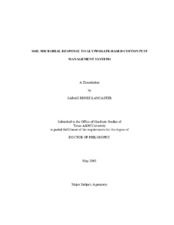| dc.description.abstract | Currently, 74% of cotton acres in the United States are planted with glyphosatetolerant
varieties. The average glyphosate-tolerant cotton crop is treated with glyphosate
2.1 times each year in addition to other herbicides, insecticides, and fungicides. The
primary objectives of this research were to: 1) describe the influence of glyphosate and
pesticides commonly applied at or near the time of cotton planting on soil microbial
activity and biomass; 2) study the effect of glyphosate on fluometuron degradation; 3)
evaluate the response of Rhizoctonia solani to glyphosate and fluometuron; 4) study
changes in glyphosate metabolism that occur as a result of repeated glyphosate
applications; and 5) define shifts in the soil microbial community. Additionally,
methods for accelerated solvent extraction (ASE) of fluometuron from soils were
developed.
In one experiment, the addition of glyphosate reduced C-mineralization in soils treated
with fluometuron, aldicarb, or mefenoxam + PCNB formulations. However, in a second experiment, C-mineralization increased when glyphosate was applied with fluometuron
relative to fluometuron applied alone.
Accelerated solvent extraction was used in experiments which demonstrated that
application of glyphosate with fluometuron increased the rate of fluometuron
degradation in soil relative to fluometuron alone. When glyphosate was added to
minimal medium, degradation of fluometuron by R. solani was reduced and less fungal
biomass was produced. The total amount of 14C-glyphosate mineralized was reduced
when glyphosate was applied 5 times relative to 1, 2, 3, or 4 times. Incorporation of 14Cglyphosate
residues into soil microbial biomass was greater following five glyphosate
applications than one application 3 and 7 days after application (DAA). Soil fatty acid
methyl ester (FAME) profiles were altered by five glyphosate applications relative to
one application. Additionally, FAMEs common to gram-negative bacteria were present
in higher concentrations following five applications relative to 1, 2, 3, or 4 applications
both 7 and 14 DAA.
These studies indicated that: 1) glyphosate altered the soil microbial response to other
pesticides; 2) fluometuron-degrading microorganisms in soil responded differently to
glyphosate; 3) changes in the dissipation or distribution of glyphosate following repeated
glyphosate applications were associated with changes in the structural diversity of the
soil microbial community. | en |


